|
|
|
Sort Order |
|
|
|
Items / Page
|
|
|
|
|
|
|
| Srl | Item |
| 1 |
ID:
092832


|
|
|
|
|
| Publication |
2009.
|
| Summary/Abstract |
The clean development mechanism (CDM) contributes to technology transfer by financing emission reduction projects using technologies not available in the host countries. This paper provides the most comprehensive analysis of technology transfer in the CDM to-date, covering 3296 registered and proposed projects. Roughly 36% of the projects accounting for 59% of the annual emission reductions claim to involve technology transfer. Technology transfer is more common for larger projects and projects with foreign participants. Technology transfer is very heterogeneous across project types and usually involves both knowledge and equipment. As the number of projects increases, technology transfer occurs beyond the individual projects. This is observed for several of the most common project types in China and Brazil with the result that the rate of technology transfer for new projects in those countries has fallen significantly.
|
|
|
|
|
|
|
|
|
|
|
|
|
|
|
|
| 2 |
ID:
092571


|
|
|
|
|
| Publication |
2009.
|
| Summary/Abstract |
To date, studies of energy siting controversy and of environmental psychology have barely informed one another, despite the environmental-behaviour literature potentially having considerable relevance to understanding public opposition to energy projects. This paper points towards this relevance, using the example of a longitudinal study of public objections to a 21.5 MWe bioenergy gasifier proposed for Winkleigh in Devon, England. Local opinion surveys in 2004 and 2007 showed that public opposition to the proposed gasifier remained strong but also revealed some statistically significant change and correlations of wider interest. In the context of the environmental psychology literature, the dominant model of contextualised values, intention and behaviour, as well as other psychological approaches, are found to be helpful, both for making sense of the results and for informing a psychological research agenda on public objection to new energy infrastructure.
|
|
|
|
|
|
|
|
|
|
|
|
|
|
|
|
| 3 |
ID:
092566
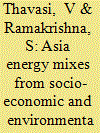

|
|
|
|
|
| Publication |
2009.
|
| Summary/Abstract |
Sustainable clean energy is the top social, economic, and environmental agenda of political leaders, policy makers, enlightened business executives, and civil society in Asia. Strong economic growth in Asia has caused a great demand for energy which has resulted in an enormous increase in CO2 emissions. The association of Southeast Asian nations (ASEAN), India, China, South Korea and Japan are the most important regions in Asia as their economies have been growing steadily. These countries though heavily dependent on fossil fuels have stepped up their measures towards low-carbon society amid domestic affordability challenges and changing global mindset. This report highlights the current energy scenario in these countries and their effort towards an affordable and sustainable clean energy future. The energy policy to enhance energy security and improve environmental sustainability is also explicated in this article.
|
|
|
|
|
|
|
|
|
|
|
|
|
|
|
|
| 4 |
ID:
092842


|
|
|
|
|
| Publication |
2009.
|
| Summary/Abstract |
This paper analyses national, regional and international biofuels policies and strategies to assess whether these policies promote or undermine the development of biofuels sector in Africa. Despite having a huge comparative advantage in land, labour and good climatic conditions favourable for the growing of energy crops, few countries in Sub-Saharan Africa have included biofuels strategies in their energy or national development policies. Further results show that while developed countries commit huge financial resources for research, technology development and the provision of tax-incentives to both producers and consumers, there is little government support for promoting biofuels in Africa. Although the consequences of biofuels on food supply remain uncertain, the mandatory blending of biofuels with fossil fuels by industrialized countries will create demand for land in Africa for the growing of energy crops for biofuels. This paper urgently calls upon national governments in Sub-Saharan Africa to develop appropriate strategies and regulatory frameworks to harness the potential economic opportunities from biofuels sector development, while protecting the environment and rural communities from the adverse effects of land alienation from the mainstream agriculture towards the growing of energy crops for biofuels at the expense of traditional food crops.
|
|
|
|
|
|
|
|
|
|
|
|
|
|
|
|
| 5 |
ID:
092813
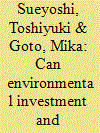

|
|
|
|
|
| Publication |
2009.
|
| Summary/Abstract |
This study investigates the causality from environmental investment (as a long-term effort) and expenditure (as a short-term effort) to financial performance in the US electric utility industry. The industry is one of the large air polluters in the United States. This empirical study finds that the environmental expenditure under the US Clean Air Act has had a negative impact from 1989 to 2001. The negative impact has become much effective after the implementation of the Title IV Program (1995) of the US Clean Air Act. This study cannot find the influence of environmental investment on financial performance by a statistical test although it indicates a positive impact. In the United States, fossil-fueled power plants such as coal-fired ones still produce a large portion of electricity. The generation structure is inconsistent with the betterment in the US environmental protection and imposes a financial burden to electric utility firms.
|
|
|
|
|
|
|
|
|
|
|
|
|
|
|
|
| 6 |
ID:
092582
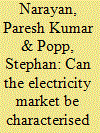

|
|
|
|
|
| Publication |
2009.
|
| Summary/Abstract |
In this paper, we test for asymmetric behaviour of industrial and residential electricity demand for the G7 countries, using the entropy-based test for symmetry suggested by [Racine, J., and Maasoumi, E., 2007. A versatile and robust metric entropy test of time-reversibility, and other hypotheses. Journal of Econometrics 138(2), 547-567; Racine, J., and Maasoumi, E., 2008. A robust entropy-based test of asymmetry for discrete and continuous processes. Econometric Reviews 28, 246-261], the Triples test of [Randles, R., Flinger, M., Policello, G., and Wolfe, D., 1980. An asymptotically distribution-free test for symmetry versus asymmetry. Journal of the American Statistical Association 75, 168-172] and the [Bai, J., and Ng, S., 2001. A consistent test for conditional symmetry in time series models. Journal of Econometrics 103, 225-258] test for conditional symmetry. Using data that spans over three decades, we find overwhelming evidence of conditional symmetry of residential and industrial electricity consumption. This finding implies that the use of econometric tests based on linear data generating processes is credible.
|
|
|
|
|
|
|
|
|
|
|
|
|
|
|
|
| 7 |
ID:
092736


|
|
|
|
|
| Publication |
2009.
|
| Summary/Abstract |
The hypothesis of this study is that there is a statistical relationship between the lung cancer mortality rate and the intensity of fuel consumption (measured in gallons/square mile) at a particular location. We estimate cross-section regressions of the mortality rate due to lung cancer against the intensity of fuel consumption using local data for the entire US, before the US Clean Air Act (CAA) in 1974 and after the most recent policy revisions in 2004. The cancer rate improvement estimate suggests that up to 10 lung cancer deaths per 100,000 residents are avoided in the largest urban areas with highest fuel consumption per square mile. In New York City, for instance, the mortality reduction may be worth about $5.7 billion annually. Across the US, the estimated value of statistical life (VSL) benefit is $27.2 billion annually. There are likely three inseparable reasons that contributed importantly to this welfare improvement. First, the CAA regulations mandated reduction in specific carcinogenic chemicals or smog components. Second, technologies such as the catalytic converter (CC) and low-particulate diesel engine were adopted. Third, biofuels have had important roles, making the adoption of clean air technology possible and substituting for high emission fuels.
|
|
|
|
|
|
|
|
|
|
|
|
|
|
|
|
| 8 |
ID:
092784


|
|
|
|
|
| Publication |
2009.
|
| Summary/Abstract |
This paper applies the so-called Multi-Scale Integrated Analysis of Societal and Ecosystem Metabolism (MuSIASEM), based on Georgescu-Roegen's fund-flow model, to the Spanish region of Catalonia. It arrives to the conclusion that within the context of the end of cheap oil, the current development model of the Catalan economy, based on the growth of low-productivity sectors such as services and construction, must be changed. The change is needed not only because of the increasing scarcity of affordable energy and the increasing environmental impact of present development, but also because of the aging population. Moreover, the situation experienced by Catalonia is similar to that of other European countries and many other developed countries. This implies that we can expect a wave of major structural changes in the economy of developed countries worldwide. To make things more challenging, according to current trends, the energy intensity and exosomatic energy metabolism of Catalonia will keep increasing in the near future. To avoid a reduction in the standard of living of Catalans due to a reduction in the available energy it is important that the Government of Catalonia implement major adjustments and conservation efforts in both the household and paid-work sectors.
|
|
|
|
|
|
|
|
|
|
|
|
|
|
|
|
| 9 |
ID:
092791


|
|
|
|
|
| Publication |
2009.
|
| Summary/Abstract |
China issued its first Fuel Economy Standards (FES) for light-duty passenger vehicles (LDPV) in September 2004, and the first and second phases of the FES took effective in July 2005 and January 2008, respectively. The stringency of the Chinese FES ranks third globally, following the Japanese and European standards. In this paper, we first review the policy-making background, including the motivations, key players, and the process; and then explain the content and the features of the FES and why there was no compliance flexibility built into it. Next, we assess the various aspects of the standard's impact, including fuel economy improvement, technology changes, shift of market composition, and overall fuel savings. Lastly, we comment on the prospect of tightening the existing FES and summarize the complementary policies that have been adopted or may be considered by the Chinese government for further promoting efficient vehicles and reducing transport energy consumption. The Chinese experience is highly relevant for countries that are also experiencing or anticipating rapid growth in personal vehicles, those wishing to moderate an increase in oil demand, or those desirous of vehicle technology upgrades.
|
|
|
|
|
|
|
|
|
|
|
|
|
|
|
|
| 10 |
ID:
092583


|
|
|
|
|
| Publication |
2009.
|
| Summary/Abstract |
The policies of coal energy are currently undergoing a significant change. At the European Community level, energy concerns are dominated by environmental commitments that seem to demand coal's disappearance. The countries that for years have supplied the European energy market with this resource have confronted their future challenges in differing ways.
The history of the energy sector in Spain has been marked by important changes, and coal has been a key factor in this process. Membership in the European Union has constituted a clear transition for a historically subsidized and protected sector that now faces an uncertain role in the national energy market.
The aim of this paper is to offer an overview and analysis of the mechanisms that have been implemented in the energy sector. The first part analyzes the rationalization policies that preceded Spanish entry into the EU, giving a detailed description of the complex programs designed by the government to help mining companies. The second part analyzes later systems aimed at helping the coal industry that were implemented after the EU imposed new criteria and objectives. These systems led to the so-called "mixed model" of rationalization. This model, which is completely different from that implemented in other member states, is based on maintaining a system of subsidies that discriminate between public and private companies. The third part examines the objectives of the current system and the plans projected for the future in the context of the EU's adoption of an energy strategy that seeks to reconcile a self-sufficient energy supply with adherence to environmental commitments.
|
|
|
|
|
|
|
|
|
|
|
|
|
|
|
|
| 11 |
ID:
092749


|
|
|
|
|
| Publication |
2009.
|
| Summary/Abstract |
Biomass gasification with subsequent synthesis to liquid or gaseous biofuels generates heat possible to use in district heating (DH) systems. The purpose here is to estimate the heat sink capacity of DH systems in the individual EU nations and assess the possibilities for biomass-gasification-based co-generation of synthetic biofuels for transportation and heat (CBH) for DH systems in the EU countries. The possibilities are assessed (i) assuming different levels of competiveness relative to other heat supply options of CBH corresponding to the EU target for renewable energy for transportation for 2020 and (ii) assuming that the potential expansion of the DH systems by 2020 is met with CBH. In general, the size of the DH heat sinks represented by the existing national aggregated DH systems can accommodate CBH at a scale that is significant compared to the 2020 renewable transportation target. The possibilities for CBH also depend on its cost-competitiveness compared to, e.g., fossil-fuel-based CHP. The possible expansion of the DH systems by 2020 represents an important opportunity for CBH and is also influenced by the potential increase in the use of other heat supply options, such as, industrial waste heat, waste incineration, and CHP.
|
|
|
|
|
|
|
|
|
|
|
|
|
|
|
|
| 12 |
ID:
092738
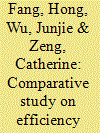

|
|
|
|
|
| Publication |
2009.
|
| Summary/Abstract |
Continually rising energy prices in global markets highlights a serious concern about the need to improve energy efficiency and the efficiency in energy sector in many countries. China, as one of the fastest growing countries in the world and the largest coal producer, has high coal consumption but a low recovery rate of coal utilization. Coal efficiency and the efficiency in coal industry have therefore attracted a great deal of attention from Chinese policy makers, coal firms and academics. This study attempts to compare the relative technical efficiency performance of listed coal mining companies in China and the US using CCR and BCC models in the advanced DEA linear programming. The results show that the level of relative efficiency in Chinese coal mining enterprises, regardless of total technical efficiency or decomposed pure technical and scale efficiency, is much lower than in American coal firms. The study also highlights the input resources that cause the inefficiency of Chinese coal mining companies. Furthermore, in-depth discussion and analysis of how the institutional environments of the two countries could cause the differences are provided.
|
|
|
|
|
|
|
|
|
|
|
|
|
|
|
|
| 13 |
ID:
092804


|
|
|
|
|
| Publication |
2009.
|
| Summary/Abstract |
Global warming and the associated changes in the world climate pattern have been accepted world wide as the gravest threat to humanity in the 20th century. To mitigate the impacts of global warming, the Kyoto Protocol was established in 1997 with the objective of reducing global greenhouse gases (GHGs) emission, in particular carbon dioxide (CO2), by 5.2% below 1990 levels. Developed nations that ratified the Protocol are committed to GHG reduction targets while developing nations are encouraged to reduce GHG emissions on a voluntary basis. Since most of the GHGs emissions come from the energy sector, energy policy plays an important role in fulfilling the Kyoto Protocol obligations. This year marks the beginning of the commitment period for the 2012 Kyoto Protocol. In this case, it would be worthwhile to compare the energy policies in Malaysia and Japan as these nations move towards fulfilling their obligations towards the Kyoto Protocol; bearing in mind that both countries ratified the Protocol, but that Japan commits a reduction target of 6% while Malaysia bears no obligation. Based on the comparison, recommendations were made on how a developing nation like Malaysia could adopt the policies implemented in Japan to suit local conditions and contribute significantly to GHG reduction.
|
|
|
|
|
|
|
|
|
|
|
|
|
|
|
|
| 14 |
ID:
092737


|
|
|
|
|
| Publication |
2009.
|
| Summary/Abstract |
The Fourth Assessment Report of IPCC reports that greenhouse gas emissions can be reduced by about 30-50% in 2030 at costs below 100 US$/tCO2 based on an assessment of both bottom-up and top-down studies. Here, we have looked in more detail into the outcomes of specific models and also analyzed the economic potentials at the sectoral and regional level. At the aggregated level, the findings of the IPCC report are confirmed. However, substantial differences are found at the sectoral level. At the same time, there seems to be no systematic difference in the reduction potential reported by top-down and bottom-up approaches. The largest reduction potential as a response to carbon prices exists in the energy supply sector. Reduction potential in the building sector may carry relatively low costs. Although uncertainties are considerable, the modeling results and the bottom-up analyses all suggest that at the global level around 50% of greenhouse gas emissions may be reduced at carbon price (costs) below 100$/tCO2-eq-but with a wide range of 30-60%. At a carbon price (costs) less than 20$/tCO2-eq, still 10-35% of emissions may be abated. The variation of results is higher at low carbon-price levels than at high levels.
|
|
|
|
|
|
|
|
|
|
|
|
|
|
|
|
| 15 |
ID:
092726
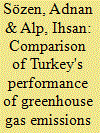

|
|
|
|
|
| Publication |
2009.
|
| Summary/Abstract |
Turkey signed the Kyoto Protocol on February 17th, 2009. Therefore, to fulfill the liabilities of the Kyoto Protocol, she has to review her status and make strategic plans to hold the emissions at the levels specified in the protocol. For this purpose, in this study employing data envelopment analysis (DEA), Turkey's greenhouse gas (GHG) emissions and local/regional pollutants compared to the European Union (EU) countries have been put in place. Since the data on Malta and Cyprus was inadequate, these two nations were excluded from the evaluation. As a candidate for EU, Turkey is required to reduce the emissions by 8% until 2012 within the framework of the Kyoto Protocol.
Two models were considered in this performance work: (i) the first model for the input energy consumption, GHG and local/regional pollutants (total GHG, CO2, F (emissions of non-methane volatile organic compounds), CO, NO2, SO2) has been considered as the output value. (ii) In the second model, the values entered in the sectoral energy consumption have been considered as GHG emissions and local/regional pollutants output. Model 2 was taken into account in which different inputs were employed to observe the impacts of input values causing GHG emissions on emission. DEA technique is used, which holds the output constant in the direction which should reduce the input. For this purpose, the effect of sectoral energy consumption on total emission was identified and it was aimed to identify on which energy resources the strategy developed for emission reduction should be.
|
|
|
|
|
|
|
|
|
|
|
|
|
|
|
|
| 16 |
ID:
092751


|
|
|
|
|
| Publication |
2009.
|
| Summary/Abstract |
This paper presents a comprehensive design of electricity transmission charges that are meant to recover regulated network costs. In addition, these charges must be able to meet a set of inter-related objectives. Most importantly, they should encourage potential network users to internalize transmission costs in their location decisions, while interfering as least as possible with the short-term behaviour of the agents in the power system, since this should be left to regulatory instruments in the operation time range. The paper also addresses all those implementation issues that are essential for the sound design of a system of transmission network charges: stability and predictability of the charges; fair and efficient split between generation and demand charges; temporary measures to account for the low loading of most new lines; number and definition of the scenarios to be employed for the calculation and format of the final charges to be adopted: capacity, energy or per customer charges. The application of the proposed method is illustrated with a realistic numerical example that is based on a single scenario of the 2006 winter peak in the Spanish power system.
|
|
|
|
|
|
|
|
|
|
|
|
|
|
|
|
| 17 |
ID:
092603
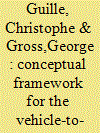

|
|
|
|
|
| Publication |
2009.
|
| Summary/Abstract |
The paper focuses on presenting a proposed framework to effectively integrate the aggregated battery vehicles into the grid as distributed energy resources to act as controllable loads to levelize the demand on the system during off-peak conditions and as a generation/storage device during the day to provide capacity and energy services to the grid. The paper also presents practical approaches for two key implementation steps - computer/communication/control network and incentive program.
|
|
|
|
|
|
|
|
|
|
|
|
|
|
|
|
| 18 |
ID:
092768


|
|
|
|
|
| Publication |
2009.
|
| Summary/Abstract |
Many economists such as Wilson (2002) [Wilson, R., 2002. Architecture of power market, Econometrica, 70, 1299-1340] have considered that there are similarities between electricity and gas services in the US electric utility industry. Hence, they expect a synergy effect between them. However, the two businesses do not have technology similarities at the level that the gas service produces a synergy effect with electricity. To examine whether there is a synergy effect of corporate diversification in the industry, we compare electricity-specialized firms with diversified utility firms in terms of their financial performance and corporate value. The comparison indicates that core business concentration is more effective for electric utility firms than corporate diversification under the current US deregulation policy.
|
|
|
|
|
|
|
|
|
|
|
|
|
|
|
|
| 19 |
ID:
092579


|
|
|
|
|
| Publication |
2009.
|
| Summary/Abstract |
Some European experts on normalization of transport fuels have recently suggested the suppression of the cetane-number limitation from the European biodiesel norm when its final destination is blending with diesel fuel. Although this measure should not affect the range of oils used for biodiesel production (only few of them lead to biodiesel fuels with cetane numbers below this limit), the trend of cetane number to decrease with increasing unsaturation could reinforce the arguments to maintain the iodine-number limitation as an indirect limit for the cetane number.
The iodine number has frequently been subjected to controversy because its stringent limitation in Europe prevents from using differently unsaturated fatty oils for biodiesel production. Some of the arguments in favour of extending or eliminating the iodine-number limitation in the norm are exposed here. Previously, a correlation for the estimation of the cetane number based on a literature review is proposed. From this correlation, a procedure is proposed for the estimation of the limiting effect of the current cetane-number limitation on the unsaturation degree of biodiesel fuels. Finally, the impact of the elimination of the cetane-number limitation on the use of different oils for biodiesel production is analyzed.
|
|
|
|
|
|
|
|
|
|
|
|
|
|
|
|
| 20 |
ID:
092787


|
|
|
|
|
| Publication |
2009.
|
| Summary/Abstract |
Environmental problems, especially "climate change" due to significant increase in anthropogenic greenhouse gases, have been on the agenda since 1980s. Among the greenhouse gases, carbon dioxide (CO2) is the most important one and is responsible for more than 60% of the greenhouse effect. The objective of this study is to identify the factors that contribute to changes in CO2 emissions for the Turkish economy by utilizing Log Mean Divisia Index (LMDI) method developed by Ang (2005) [Ang, B.W., 2005. The LMDI approach to decomposition analysis: a practical guide. Energy Policy 33, 867-871]. Turkish economy is divided into three aggregated sectors, namely agriculture, industry and services, and energy sources used by these sectors are aggregated into four groups: solid fuels, petroleum, natural gas and electricity. This study covers the period 1970-2006, which enables us to investigate the effects of different macroeconomic policies on carbon dioxide emissions through changes in shares of industries and use of different energy sources. Our analysis shows that the main component that determines the changes in CO2 emissions of the Turkish economy is the economic activity. Even though important changes in the structure of the economy during 1970-2006 period are observed, structure effect is not a significant factor in changes in CO2 emissions, however intensity effect is.
|
|
|
|
|
|
|
|
|
|
|
|
|
|
|
|
|
|
|
|
|